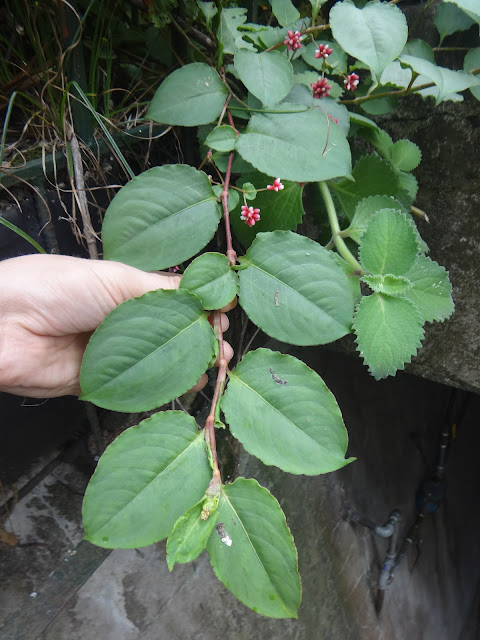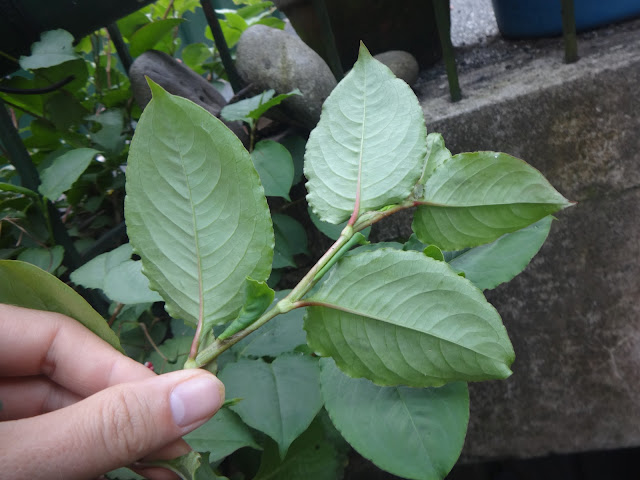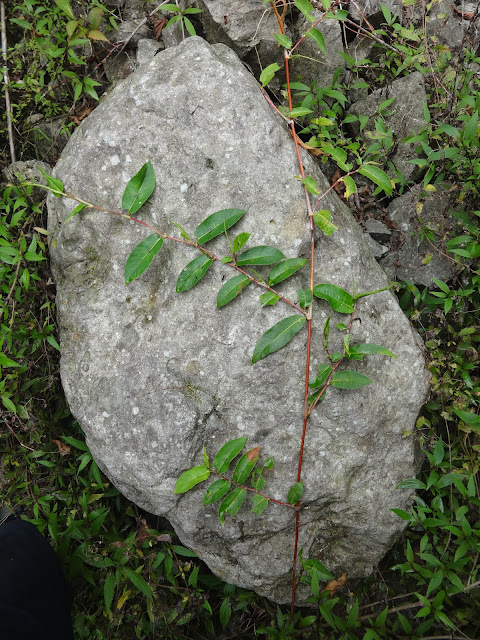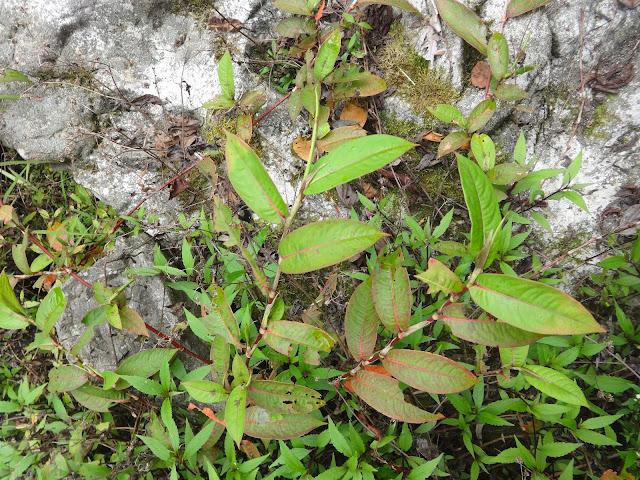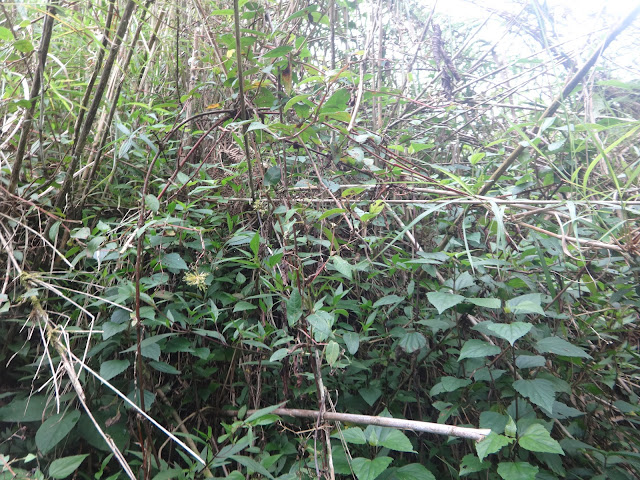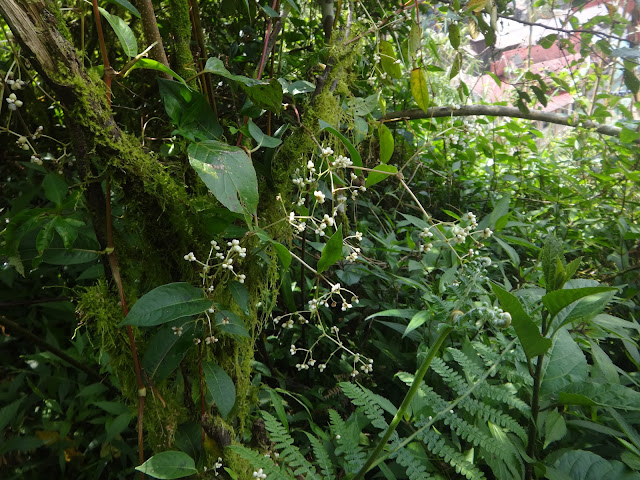PLANT PROFILE
Polygonum chinense is a robust perennial, herbaceous plant, with stems stiff enough to form erect shrub up to around 1m height, but as it grows longer it has a tendency to lean or climb on nearby bushes, fences etc (even up to 10m high). It is native to wide region of subtropical and warm temperate Asia that spread from India, Sri Lanka and Himalaya region, through whole Southeast Asia to Korea, Japan, Taiwan, the Philippines, Indonesia and Papua New Guinea. It also has been introduced to Pakistan, Hawaii, Australia, New Zealand, La Reunion and Jamaica.
Its leaves can widely vary, from elliptic and ovate to oblong and oblong-lanceolate, with glabrous or hispid surface, and its flowers can be either white or red-pink. This variability has been recognized in botanical classification, and nowadays four different types of Polygonum chinense are officially accepted : Polygonum chinense var. chinense, Polygonum chinense var. ovalifolium, Polygonum chinense var. paradoxum and Polygonum chinense var. hispidum.
All those types of Chinese Knotweed are widely used by folk healers and herbalists in most of the regions where it grows in wild, and it is sometimes (but rarely) also grown in gardens for use as a medicine or leafy vegetable. Polygonum chinense var. ovalifolium is also being cultivated for its ornamental value, as its red-pink flowers gives it a lots of charm.
Polygonum chinense var. ovalifolium
Polygonum chinense var. chinense
Although Polygonum chinense var. ovalifolium with its red-pink flowers and broad leaves, differs much in its appearance from other forms of Polygonum chinense, with white flowers and much longer and slimmer leaves. I didn't noticed any difference between taste of infusion made from fresh leaves of ovalifolium and tea from fresh leaves of P. chinense var. chinense. I also haven't found any information either about traditional medicinal use or scientific data that would suggest any difference in medicinal value between P. ovalifolium and the white flower varieties.
In Manipur, India, Polygonum chinense is utilized as an adhesive for dark color. Crushed whole plant is soaked in water for 2 to 3 days and the liquid is used as dye.
In Australia and New Zealand there is a quite of a witch hunt going on against Polygonum chinense. It is hard for me to debate how serious or not this plant can be a threat to their native plants or local crops. But promotion of using toxic chemical herbicides that pollute the environment (by government organization which duty is to protect it), to eradicate introduced plant species that is great source of natural medicine and also a food. Is morally wrong and highly illogical even if that plant is invasive.
My advice to the farmers that might have problem with natural, not chemical, control of P. chinense as a weed on their crops. If can't fight it, just embrace it. As I am sure that with the current popularity of herbal remedies, globally and particularly in Australia and New Zealand itself. You can earn good money harvesting and selling organic Chinese Knotweed, instead of your regular old crop plant contaminated with herbicides (which usually also distort growth of that crop directly, and indirectly by destroying beneficial soil microorganisms lowering the soil fertility, and that means lower crop yield sometimes for years).
Polygonum chinense is nowadays the most commonly used botanical name for this species worldwide, but Persicaria chinensis is also often used. This plant posses also many other synonims that can be found in old books, here are some of it : Polygonum auriculatum Meisn., Polygonum densiflorum Blume, Polygonum ovatum B.Heyne, Polygonum patens D.Don, Polygonum umbellatum (Houtt.) Koidz., Persicaria umbellata (Houtt.) Nakai, Rumex umbellatus Houtt., Ampelygonum chinense (L.) Lindl., Ampelygonum umbellatum (Houtt.) Masam., Coccoloba indica Wight ex Meisn., Coccoloba asiatica Lour..
Polygonum chinense is most commonly known as Chinese Knotweed, and it is also called Mountain Knotweed, Creeping Smartweed, Rice Smartweed or Hill Buckwheat in English. But some people use Chinese Knotweed name for Polygonum multiflorum (syn. Reynoutria multiflora and Fallopia multiflora), and to avoid confusion P. multiflorum is sometimes called Chinese Climbing Knotweed.
Polygonum chinense is also named : Huo Tan Mu, Chi Di Li, Bai Fan Cao, Lao Shu Zhe, Yun Yao, Xiao Hong Ren (in Chinese), Jangli Palak (Hindi), Bilee Kanagilu, Nir Kaniglu (Kannada), Actalaree, Sivappu, Kumbakodaali (Tamil), Jaryndem (Khasi), Piripu, Poovallikodi, Mudanthi, Oduthan, Thiruthanni (Malayalam), Kelnap, Soleng, Modhusoleng (Assamese), Angom Yensil, Leibung Tharam (Manipuri), Paral (Marathi), Neerkapachi (Irula), Taham (Mizo), Kukurthotne (Nepali), Bangori Bhanga Gaas (Bangladesh), Sembuluh (Singapore), Mahaga-kyansit, Kinn-ywet, Boktaung, Wetkyein, Maha-gar-kyan-sit (Myanmar), Qaub Yag (Laos), Bota-bota, Darnon, Kulang-kulang, Langingit, Lutudan, Vono (Philippines), Tsuru Soba (Japan), Eong Gul Mo Mil (Korea), Liane Rouge (French), Polygono da China (Portuguese).

CULTIVATION AND HARVESTING
Polygonum chinense can grow either as a shrub or a vine. Its stems are herbaceous and thin, and even when old it is not getting much thicker when it become wooden. Therefore the upward growing stems can create a bush to around 1m only, because the longer the stems grows the more it lean. And when it has some support like tall shrubs, trees, walls or fences, its stems can climb even up to 10m high. Chinese Knotweed is highly polymorphic species, with leaves shapes ranging from elliptic and ovate to oblong and oblong-lanceolate, and some of its forms are more expansive than others.
It is evergreen perennial but its leaves often turn reddish, orange or yellow without dropping, due to strong sun exposure or dry and hot weather (young leaves may also grow reddish due to phosphorus deficiency). That can add much charm to its look, but it is ultimately the beauty of the red-pink flowers that gave Polygonum chinense status of an ornamental plant. The white flowers varieties are rarely appreciated as such, as it looks rather bleak compare to vivid clusters of sweet red-pink, star shaped inflorescences. Flowering period of P. chinense is said to ranges from July to November in China, Sept. to Nov. in Pakistan and Sept. to Dec. in India (Himalaya region), and I've seen it flowering generally all year round in the Philippines. Chinese Knotweed flowers produce good amounts of nectar and are rich pollen source for honeybees.
In nature Polygonum chinense grows in subtropical and warm temperate climate regions of south and east of Asia. It can be found mainly on wastelands, roadsides, in thickets, forests, wet valleys and on hillsides and mountain slopes on elevations up to from sea level to 3000 m. It can create dense mats on the ground, entirely cover foliage of shrubs it climb on, or just loosely intergrow among stems of other plants.
Chinese Knotweed thrives in fertile loamy humid soils and can grow even in waterlogged areas, but it can also cope well with moderate droughts. Even if the aerial parts of the plant get dead dry, it can often regrow from the survived root part of the plant. It grows equally well in full sun as in partial shade, and can tolerate even strong shade. But the more shade it gets the less flowers it produce. This plant also tolerate high salinity.
Polygonum chinense can be easily grown from seeds, cuttings or threw layerings. Birds disperse the seeds that sprouts easily. And in humid conditions and rich soil, the young plants can grow rapidly and become problematic weed on agricultural lands. It is often an issue on tea plantations, where this plant can quickly overgrow and cover whole tea bushes and block drainage systems. In West Java, larvae and adults of Haltica sp. cause considerable damage to plants of P. chinensis. Therefore biological control of P. chinensis using this beetle species has been proposed.
At the present I don't have enough data to support this claim. But from my own observations I judge that Polygonum chinense var. ovalifolium growth is less robust and the plant generally reaches smaller size and is less of a competition threat for neighboring plants, than Polygonum chinense var. chinense and probably of other white flower varieties.
All parts of Polygonum chinense can be gathered all year round for medicinal purposes, to be used fresh or dried for infusions. But for eating as a vegetable, only the young leaves and tender shoots of the fast growing plants are suitable, as the older one contain too much tannins.
Young leaves and tender shoots of Polygonum chinense are sometimes eaten fresh in salads. It is slightly sour and a gently astringent, but as the leaves get older it turns to tough and tart to enjoy as a vegetable and is only suitable for a herbal tea.
The young leaves and shoots can be also used for cooking, steamed, stir-fried or pickled.
The fruits of Chinese Knotweed are edible, but although very juicy, its taste is a little bit sour and usually rather insipid.
Tea from leaves and stems of Polygonum chinense is not on the list of my most favorites herbal teas, as it is nothing special in taste and aroma. But it is definitely one of those herbal infusions that you can drink for sheer pleasure of it, and just for its medicinal purposes. Chinese Knotweed makes a pleasant tasting tea, very nice to accompany a meal, or just for a relaxing tea time on its own. The fresh leaves and stems tea has mild taste, without any bitterness, it is slightly sour and gently astringent. The tea from dried P. chinense taste much the same as the one made from fresh one, but its character changes a bit and resemble that of o Green Tea (Camelia sinensis) with lemon.
Dried plant of Polygonum chinense contains more vitamin C (ascorbic acid) than lemon juice.
Polygonum chinense var. hispidum is one of the key ingredients in Cantonese herbal tea, that is quite popular local beverage in Ling Nan area of China.
MEDICINAL USES
Polygonum chinense is an important herbal remedy for many indigenous communities of region that spreads from Himalayas to Korea, Japan and Papua New Guinea. It is not very popular in contemporary mainstream herbalism even in countries of the region, but has a strong significance as a medicinal plant in Traditional Chinese Medicine and Ayurvedic medicine. And in recent years few studies on its pharmacological actions and bioactive constituents has been conducted in India, China, Malaysia and Vietnam.
Medicinal actions of Polygonum chinense are described as : antibacterial, antimicrobial, antifungal, antiviral, anti-inflammatory, antipyretic, astringent, hepatoprotective, gastro-protective, anti-ulcerogenic, digestive, deobstruent, anti-hypertensive, depurative, tonic, diuretic, vulnerary, antiscorbutic and CNS-inhibitory.
In terms of Traditional Chinese Medicine, aerial parts of Chinese Knotweed are described as mildly astringent and acidic, cool in nature, clearing heat and removing dampness, improving circulation, cooling the blood, promoting diuresis, detoxifying and stopping itch.
The roots of Polygonum chinense are described as acid and sweet, are said to promote Qi and used to treat Qi deficiency and dizziness, tinnitus and deafness.
Orally the whole plant of Polygonum chinense is usually taken in form of infusions or decoctions both fresh and dry and rarely alcoholic extracts are also made of it . But sometimes the leaves are simply consumed raw, leaf juice is squeezed out for drinking, or the whole plant is taken in form of powder. It is used to treat conditions such as :
- Gastrointestinal problems. Chinese Knotweed is commonly taken as a remedy for many gastrointestinal ailments, such as indigestion, diarrhoea, dysentery, enteritis, gastroenteritis, bloody stool, ulcers, intestinal worms and hemorrhoids.
As a treatment of stomachache P. chinense is not only consumed, but also poultice of fresh smashed leaves and young stems is applied for abdomen (dried whole plant can be also applied after soaking in water).
Ethanol extract of root of P. chinense was reported to be effective in obliterating Helicobacter pylori in the stomach.
- Inflammation. Polygonum chinense is widely used to treat inflammation of many different kinds, mainly those of upper part of digestive tract (gingivitis, tonsillitis, pharyngitis) and gastrointestinal (enteritis, gastroenteritis, hemorrhoids), but also those of respiratory system (laryngitis, asthma, bronchitis, pneumonia), liver, lymph-node, breasts, vaginal and skin inflammation.
Anti-inflammatory activity of P. chinense methanolic extract was confirmed both in vitro and in vivo, with significant reduction of levels of LPS-mediated proinflammatory cytokines.
- Infectious diseases. Chinese Knotweed is commonly used to treat infectious diseases, bacterial, fungal and also some viral or caused by other microbes. Mainly those of a stomach (diarrhea, dysentery, Helicobacter pylori) respiratory system (cold, diphtheria, whooping cough - pertussis, pneumonia) and skin infections (carbuncle, impetigo, shingle, cold sore, scabies), but also other like fungal vaginitis or intestinal worms infestation, and in general as a fever treatment.
Studies has showed that Polygonum chinense extracts are effective against both Gram-positive and Gram-negative bacteria strains, like Bacillus subtilis, Stapphylococcus aureus, Escherichia coli, Pseudomonas aeruginosa and Helicobacter pylori.
The antifungal test showed significant activity against Aspergillus niger and moderate activity on Candida albicans.
Studies results demonstrated that P. chinense and its metabolites possess effective anti-influenza virus activities. Polygonum chinense has shown to target virus nucleoprotein (essential protein for virus transcription and replication), including oseltamivir-resistant ones.
- Lungs problems. In Traditional Chinese Medicine, P. chinense is used to treat various lung ailments, like cough, bronchitis, asthma, pneumonia and even cancer.
Studies result has showed that Polygonum chinense water decoction can be used to against viral pneumonia, as PCWD treatment remarkably reduced the ALI (acute lung injury) and systemic inflammation, while reducing the virus reproduction in airway epithelial tissue.
- Liver ailments. Chinese Knotweed is often used to protect the liver and treat liver conditions like hepatitis and jaundice. In Traditional Chinese Medicine it is said to be suitable for jaundice of damp-heat type, one recommendation for such a condition is to decoct in water 25g of P. chinense with 25g of Abrus cantoniensis.
Studies showed that alcohol extracts of Polygonum chinense exhibit strong hepatoprotective activity. Chinese study showed in vivo antitumor activity of Polygonum chinense against human hepatocellular carcinoma cell line Bel-7404.
- Eye disease. Polygonum chinense is traditionally consumed to treat eye diseases, it is said to sharpen vision and relieve corneal opacity.
Some sources mention use of the plant juice for eye diseases, and although made it unclear if it is about external use, I believe it might be effective for some conditions as an eye drops (especially for those problems caused by infections and inflammation but maybe also be helpful in glaucoma). Please let me know if you have any knowledge of external use of Chinese Knotweed for treatment of eye problems.
- Women's ailments. This herb is traditionally used to treat women's health issues such as fungal vaginitis (decoctions are not only consumed but also used as a hot sitz bath and vaginal douche, and the dry plant powder is sprinkled locally after), vaginal discharge, irregular menses, metrorrhagia, postpartum bleeding and mastitis.
In rural India, the decoction of P. chinense plant mixed with jaggery is given to women as a part of post-natal care.
- Allergies. As a treatment for allergies leaf extract is drunk for 2-3 days.
- Skin problems. P. chinense is widely used to treat many different kinds of skin ailments, not only those caused by infections and inflammation but also the one due to allergies and other factors.
It is both consumed and applied externally as a fresh plant paste (decoctions are also sometimes used as wash), to treat eczema, abscesses, carbuncles, impetigo, shingle, cold sore, scabies, anthrax, insect stings, sores, hemorrhoids, pruritus and pediatric pustules. It is also believed to act as vulnerary herb (speed up and improve wound healing) and is used both internally and externally to treat wounds and hemorrhages.
- Snakebites and scorpion stings. This plant is often used as a remedy for poisonous snakebite (one recommendation for treatment is to drink fresh leaves juice (20 - 30g), and apply the leaves residue as a plaster on the bite place). It is also mentioned as a cure to counteract poison from scorpion bite.
Chinese Knotweed is also consumed as treatment of : nerve damage, paralysis, spasms, lower limb pain, asthenia, traumatic injuries, kidney and urinary diseases, aphthae, ulceration of the helix, dizziness, heat dizziness, infantile summer fever, and to quench thirst, relief colic pain, and as an antiscorbutic and tonic.
Externally Polygonum Chinense is used as :
- Fresh plant paste poultice or a juice or decoction, is applied on boils, abscesses, impetigo, cold sore, dermatosis, erysipelas, anthrax, pruritus, sprains, bruises, traumatic injuries and poisonous snake bite.
- The decoction is used to treat eczema of the ears.
- Poultice of fresh smashed leaves and stems or dried one after soaking in water, is applied to the abdomen as a treatment for stomach-ache.
- Paste from the leaves ground with lemon juice is applied all over the head for giddiness.
Whole plant of Polygonum chinense is rich in terpenoids (mainly squalene and 1,2-benzenedicarboxylic acid, mono[2-ethylhexyl]ester) and contains alkaloids, flavonoids (flavones, flavanones), phenolic acids, ellagic acid, tannins (ellagitannins), steroids, saponins, glycosides, gums, as also coumarins and calcium oxalate.
These are some of its compounds : hecogenin, dotriaeontanol, aurantiamide, rheumemodin, stigmastane-3,6-ione, 25-r-spirost-4-ene-3,12-dione, dotriaeontanol, beta-sitosterol, methyl 3,4,5-trihydroxybenzoate, daucosterol, 3,4,5-trihydroxybenzoic acid, quercetin, quercitrin, hyperoside, 8-methyl octahydrocoumarin, ethyl gallate, geraniin, chebulagic acid, kaempferol, phenolic amide.
P. chinensis is rich in ascorbic acid (56.94mg/100g dried weight), coper (2.60mg/100 g d. w.), essential amino acids histidine and valine, and also taurine.
Polygonum chinense var. ovalifolium

Polygonum chinense var. chinense

On the photos below you can see weird fungus(?) that I saw few times growing on Polygonum chinense var. chinense flowers or fruits. I've found it in the Philippines, north of Luzon island in Benguet, Cordillera, on Mount Santo Tomas and in Tam-awan Village.

Sources
'' Common Medicinal Plants of the Cordillera Region (Northern Luzon, Philippines) '' - Leonardo L. Co, CHESTCORE Baguio City 2011
'' Chinese Medicinal Herbs of Macao (Volume 1) '' - Chan Shek-Kiu and Wu Qi-Gen, University of Macau 2003
'' Medicinal Plants of Asia and the Pacific '' - Christophe Wiart, CRC Press 2006
'' Medicinal Plants '' - Moshrafuddin Ahmed, MJP Publisher 2019
'' CRC World Dictionary of Medicinal and Poisonous Plants '' - Umberto Quattrocchi, CRC Press 2012
'' Ethnobotany of India, Volume 2: Western Ghats and West Coast of Peninsular India '' - T. Pullaiah, K. V. Krishnamurthy, Bir Bahadur, CRC Press 2016
'' Taxonomic diversity of broad-leaf weeds at Bangladesh Agricultural University campus and their ethno-botanical uses '' - Most. Morsada Khatun, Md. Ashik Mia, A.K.M. Golam Sarwar
Polygonum chinense water decoction lessens acute lung injury in mice induced by influenza virus - Rongkui Liu, Zhao Zhang, Xueyang Peng, Yueling Su, Yan Xiao, Xiuli Ji
Phytochemical and biological research of Polygoneae medicinal resources - Da Cheng Hao, Xiao-Jie Gu, Pei Gen Xiao
Gastroprotective Activity of Polygonum chinense Aqueous Leaf Extract on Ethanol-Induced Hemorrhagic Mucosal Lesions in Rats - Iza Farhana Ismail, Shahram Golbabapour, Pouya Hassandarvish, Maryam Hajrezaie, Nazia Abdul Majid, Farkaad A. Kadir, Fouad Al-Bayaty, Khalijah Awang, Hazrina Hazni and Mahmood Ameen Abdulla
HEPATOPROTECTIVE AND CYTOTOXIC POTENTIAL OF ETHANOLIC LEAF EXTRACT OF Polygonum chinense L. - MANOJ KUMAR DAS
Comprehensive identification of potential antioxidant components in the aerial parts of Polygonum chinense L. var. hispidum using ultra high performance liquid chromatography coupled with quadrupole time-of-flight mass spectrometry - Hongwu Zhang, Meng Yu, Hongmei Jia, Tao Zhang, Hai Shang, Mengli Zhang, Ziya Zhu, Zhongmei Zou
AP-1-Targeting Anti-Inflammatory Activity of the Methanolic Extract of Persicaria chinensis -Muhammad Jahangir Hossen, Seung Cheol Kim, Young-Jin Son, Kwang-Soo Baek, Eunji Kim, Woo Seok Yang, Deok Jeong, Jae Gwang Park, Han Gyung Kim, Woo-Jae Chung, Keejung Yoon, Chongsuk Ryou et al.
In vivo and in vitro anti-inflammatory activities of Persicaria chinensis methanolic extract targeting Src/Syk/NF-κB - Muhammad Jahangir Hossen, Kwang-Soo Baek, Eunji Kim, Woo Seok Yang, Deok Jeong, Jun Ho Kim, Dae-Hyuk Kweon, Deok Hyo Yoon, Tae Woong Kim, Jong-Hoon Kim, Jae Youl Cho
GC-MS analysis of phytocomponents in the ethanol extract of Polygonum chinense L - Bagavathi Perumal Ezhilan and Ramasamy Neelamegam
Bioactive sesquiterpene, plasticizer, and phenols from the fungal endophytes of Polygonum chinense L. - Madhuchhanda Das, Harischandra Sripathy Prakash & Monnanda Somaiah Nalini
A bioactivity-guided study on the anti-diarrheal activity of Polygonum chinense Linn - Hai-Tao Xiao, Siu-Wai Tsang, Hong-Yan Qin, Franky F.K. Choi, Zhi-Jun Yang, Quan-Bin Han, Hu-Biao Chen, Hong-Xi Xu, Hong Shen, Ai-Ping Lu, Zhao-Xiang Bian Morphological, Microscopical Studies and Elemental analysis of Polygonum chinense L. and Rhoeo discolor Hance - Moe Moe Lwin
Nutraceutical properties of Stellaria media (L.) Vill. and Persicaria chinensis (L.) H. Gross under Brahmaputra valley agro-climatic condition - Pranjal Sarmah, Aniruddha Sarma, Debaleena Kashyap, Mantu Mahanta, Pramod Medhi
Amino acid profiles and anti-nutritional contents of traditionally consumed six wild vegetables -Hwiyang Narzary, Sanjay Basumatary
Traditional Chinese Medicine in Treating Influenza: From Basic Science to Clinical Applications - Yibai Xiong, Na Xiao Li, Naifang Duan, Bin Liu, Hui Zhu, Chi Zhang, Li Li, Cheng Lu and Luqi Huang










